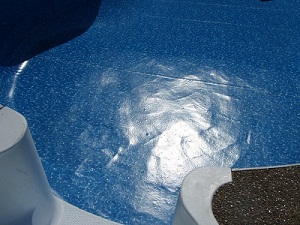Pool Inspection
The first step in trying to isolate a leak in a swimming pool is to inspect the pool for any signs of damage. This is the same process that you would use if
you were inspecting a new swimming pool or if you are considering buying a house with a pool as any signs of damage are certain to end up costing you money
sooner or later if you are responsible for the pool.
Assuming the pool was ever in reasonable condition at some point in its life then you can assume any abnormalities that you see to be a problem. A
trained industry expert can likely tell with greater accuracy than the average home owner the severity of any given pool damage, but just consider that the
pool was built to be perfect and something has gone wrong in any area where you see something that looks "funny".

This can be cracks in the deck or sinking or uneven pool decks, coping cracks or failures, liner rips or patches, lumps or bumps under a pool liner, cracks
in a concrete pool, tiles falling off the wall etc.
All of these are signs of problems currently developing and swimming pools have a bad reputation for being expensive to repair. If the pool is losing water
then you know that there is a problem. If you also see physical damage this is an indication that part of the pool has failed so the two could very likely
be related.
How To Inspect A Pool For Leaks
You may not know where to look for signs of damage in a swimming pool so consider the following tips are potential things to watch out for:
Vinyl Liner Pools (look for holes, wrinkles, lumps, patches etc)
Concrete Pools (look for missing tiles, cracks on the walls floors and feel plaster surface. It should be smooth. Rough means it needs renovation
soon)
Skimmer (this is the source for many problems. Inspect the throat between the pool and the skimmer and the inside and bottom of the body for cracks)
Deck (look for cracks, fissures, sinking or water pooling)
Pool Level (Check the waterline to see if the pool looks level from end to and and side to side)
One of the harder things to tell from standing on the pool deck is the condition of the walls and especially the floor of the pool. This can become
impossible if the pool water is cloudy or dark from algae. If you visibly can not see the floor then this alone is a bad sign but you may be able to still
draw some basic conclusions by using a pole and brush to roughly determine the condition and shape of the floors and slopes underwater.
Swimming Pool Deficiencies
At this stage you are still only creating a profile of your pool to determine through a process of elimination where the leak is. Any deficiencies in the pool
should be thoroughly noted and inspected. When you inspect really what you are doing most of all is looking closely for cracks.
For example a skimmer can crack down on the bottom of the inside or sometimes in the throat waterway that connects the pool to the skimmer. Cracks in these
areas can go undetected for long periods of time so be sure to inspect all areas closely with decent lighting. If anything looks out of place with the pool
you can assume that repairs will be required in the future if not the near future if this turns out to be the cause of the leak. Sometimes the deficiency can
actually be a symptom of the larger problem but in either case the visible damage is the warning flag.
Now you can continue to the section dealing with water loss characteristics to continue diagnosing you pool leak problem.
The menu on the right is a chronological step by step process to determine where a swimming pool is leaking. This website is written as a readthrough
technical assistance guide for locating leaks. When you believe you have identified where the pool is leaking you need to go to our sister website to see
pictures and learn more about the actual swimming pool leak repair process.
